Chunyan Miao
Adapt in the Wild: Test-Time Entropy Minimization with Sharpness and Feature Regularization
Sep 05, 2025Abstract:Test-time adaptation (TTA) may fail to improve or even harm the model performance when test data have: 1) mixed distribution shifts, 2) small batch sizes, 3) online imbalanced label distribution shifts. This is often a key obstacle preventing existing TTA methods from being deployed in the real world. In this paper, we investigate the unstable reasons and find that the batch norm layer is a crucial factor hindering TTA stability. Conversely, TTA can perform more stably with batch-agnostic norm layers, i.e., group or layer norm. However, we observe that TTA with group and layer norms does not always succeed and still suffers many failure cases, i.e., the model collapses into trivial solutions by assigning the same class label for all samples. By digging into this, we find that, during the collapse process: 1) the model gradients often undergo an initial explosion followed by rapid degradation, suggesting that certain noisy test samples with large gradients may disrupt adaptation; and 2) the model representations tend to exhibit high correlations and classification bias. To address this, we first propose a sharpness-aware and reliable entropy minimization method, called SAR, for stabilizing TTA from two aspects: 1) remove partial noisy samples with large gradients, 2) encourage model weights to go to a flat minimum so that the model is robust to the remaining noisy samples. Based on SAR, we further introduce SAR^2 to prevent representation collapse with two regularizers: 1) a redundancy regularizer to reduce inter-dimensional correlations among centroid-invariant features; and 2) an inequity regularizer to maximize the prediction entropy of a prototype centroid, thereby penalizing biased representations toward any specific class. Promising results demonstrate that our methods perform more stably over prior methods and are computationally efficient under the above wild test scenarios.
Context Pooling: Query-specific Graph Pooling for Generic Inductive Link Prediction in Knowledge Graphs
Jul 10, 2025Abstract:Recent investigations on the effectiveness of Graph Neural Network (GNN)-based models for link prediction in Knowledge Graphs (KGs) show that vanilla aggregation does not significantly impact the model performance. In this paper, we introduce a novel method, named Context Pooling, to enhance GNN-based models' efficacy for link predictions in KGs. To our best of knowledge, Context Pooling is the first methodology that applies graph pooling in KGs. Additionally, Context Pooling is first-of-its-kind to enable the generation of query-specific graphs for inductive settings, where testing entities are unseen during training. Specifically, we devise two metrics, namely neighborhood precision and neighborhood recall, to assess the neighbors' logical relevance regarding the given queries, thereby enabling the subsequent comprehensive identification of only the logically relevant neighbors for link prediction. Our method is generic and assessed by being applied to two state-of-the-art (SOTA) models on three public transductive and inductive datasets, achieving SOTA performance in 42 out of 48 settings.
FreRA: A Frequency-Refined Augmentation for Contrastive Learning on Time Series Classification
May 29, 2025Abstract:Contrastive learning has emerged as a competent approach for unsupervised representation learning. However, the design of an optimal augmentation strategy, although crucial for contrastive learning, is less explored for time series classification tasks. Existing predefined time-domain augmentation methods are primarily adopted from vision and are not specific to time series data. Consequently, this cross-modality incompatibility may distort the semantically relevant information of time series by introducing mismatched patterns into the data. To address this limitation, we present a novel perspective from the frequency domain and identify three advantages for downstream classification: global, independent, and compact. To fully utilize the three properties, we propose the lightweight yet effective Frequency Refined Augmentation (FreRA) tailored for time series contrastive learning on classification tasks, which can be seamlessly integrated with contrastive learning frameworks in a plug-and-play manner. Specifically, FreRA automatically separates critical and unimportant frequency components. Accordingly, we propose semantic-aware Identity Modification and semantic-agnostic Self-adaptive Modification to protect semantically relevant information in the critical frequency components and infuse variance into the unimportant ones respectively. Theoretically, we prove that FreRA generates semantic-preserving views. Empirically, we conduct extensive experiments on two benchmark datasets, including UCR and UEA archives, as well as five large-scale datasets on diverse applications. FreRA consistently outperforms ten leading baselines on time series classification, anomaly detection, and transfer learning tasks, demonstrating superior capabilities in contrastive representation learning and generalization in transfer learning scenarios across diverse datasets.
Efficient Heuristics Generation for Solving Combinatorial Optimization Problems Using Large Language Models
May 19, 2025



Abstract:Recent studies exploited Large Language Models (LLMs) to autonomously generate heuristics for solving Combinatorial Optimization Problems (COPs), by prompting LLMs to first provide search directions and then derive heuristics accordingly. However, the absence of task-specific knowledge in prompts often leads LLMs to provide unspecific search directions, obstructing the derivation of well-performing heuristics. Moreover, evaluating the derived heuristics remains resource-intensive, especially for those semantically equivalent ones, often requiring omissible resource expenditure. To enable LLMs to provide specific search directions, we propose the Hercules algorithm, which leverages our designed Core Abstraction Prompting (CAP) method to abstract the core components from elite heuristics and incorporate them as prior knowledge in prompts. We theoretically prove the effectiveness of CAP in reducing unspecificity and provide empirical results in this work. To reduce computing resources required for evaluating the derived heuristics, we propose few-shot Performance Prediction Prompting (PPP), a first-of-its-kind method for the Heuristic Generation (HG) task. PPP leverages LLMs to predict the fitness values of newly derived heuristics by analyzing their semantic similarity to previously evaluated ones. We further develop two tailored mechanisms for PPP to enhance predictive accuracy and determine unreliable predictions, respectively. The use of PPP makes Hercules more resource-efficient and we name this variant Hercules-P. Extensive experiments across four HG tasks, five COPs, and eight LLMs demonstrate that Hercules outperforms the state-of-the-art LLM-based HG algorithms, while Hercules-P excels at minimizing required computing resources. In addition, we illustrate the effectiveness of CAP, PPP, and the other proposed mechanisms by conducting relevant ablation studies.
SoftCoT++: Test-Time Scaling with Soft Chain-of-Thought Reasoning
May 16, 2025



Abstract:Test-Time Scaling (TTS) refers to approaches that improve reasoning performance by allocating extra computation during inference, without altering the model's parameters. While existing TTS methods operate in a discrete token space by generating more intermediate steps, recent studies in Coconut and SoftCoT have demonstrated that thinking in the continuous latent space can further enhance the reasoning performance. Such latent thoughts encode informative thinking without the information loss associated with autoregressive token generation, sparking increased interest in continuous-space reasoning. Unlike discrete decoding, where repeated sampling enables exploring diverse reasoning paths, latent representations in continuous space are fixed for a given input, which limits diverse exploration, as all decoded paths originate from the same latent thought. To overcome this limitation, we introduce SoftCoT++ to extend SoftCoT to the Test-Time Scaling paradigm by enabling diverse exploration of thinking paths. Specifically, we perturb latent thoughts via multiple specialized initial tokens and apply contrastive learning to promote diversity among soft thought representations. Experiments across five reasoning benchmarks and two distinct LLM architectures demonstrate that SoftCoT++ significantly boosts SoftCoT and also outperforms SoftCoT with self-consistency scaling. Moreover, it shows strong compatibility with conventional scaling techniques such as self-consistency. Source code is available at https://github.com/xuyige/SoftCoT.
A Continual Learning-driven Model for Accurate and Generalizable Segmentation of Clinically Comprehensive and Fine-grained Whole-body Anatomies in CT
Mar 16, 2025Abstract:Precision medicine in the quantitative management of chronic diseases and oncology would be greatly improved if the Computed Tomography (CT) scan of any patient could be segmented, parsed and analyzed in a precise and detailed way. However, there is no such fully annotated CT dataset with all anatomies delineated for training because of the exceptionally high manual cost, the need for specialized clinical expertise, and the time required to finish the task. To this end, we proposed a novel continual learning-driven CT model that can segment complete anatomies presented using dozens of previously partially labeled datasets, dynamically expanding its capacity to segment new ones without compromising previously learned organ knowledge. Existing multi-dataset approaches are not able to dynamically segment new anatomies without catastrophic forgetting and would encounter optimization difficulty or infeasibility when segmenting hundreds of anatomies across the whole range of body regions. Our single unified CT segmentation model, CL-Net, can highly accurately segment a clinically comprehensive set of 235 fine-grained whole-body anatomies. Composed of a universal encoder, multiple optimized and pruned decoders, CL-Net is developed using 13,952 CT scans from 20 public and 16 private high-quality partially labeled CT datasets of various vendors, different contrast phases, and pathologies. Extensive evaluation demonstrates that CL-Net consistently outperforms the upper limit of an ensemble of 36 specialist nnUNets trained per dataset with the complexity of 5% model size and significantly surpasses the segmentation accuracy of recent leading Segment Anything-style medical image foundation models by large margins. Our continual learning-driven CL-Net model would lay a solid foundation to facilitate many downstream tasks of oncology and chronic diseases using the most widely adopted CT imaging.
Continual Optimization with Symmetry Teleportation for Multi-Task Learning
Mar 06, 2025



Abstract:Multi-task learning (MTL) is a widely explored paradigm that enables the simultaneous learning of multiple tasks using a single model. Despite numerous solutions, the key issues of optimization conflict and task imbalance remain under-addressed, limiting performance. Unlike existing optimization-based approaches that typically reweight task losses or gradients to mitigate conflicts or promote progress, we propose a novel approach based on Continual Optimization with Symmetry Teleportation (COST). During MTL optimization, when an optimization conflict arises, we seek an alternative loss-equivalent point on the loss landscape to reduce conflict. Specifically, we utilize a low-rank adapter (LoRA) to facilitate this practical teleportation by designing convergent, loss-invariant objectives. Additionally, we introduce a historical trajectory reuse strategy to continually leverage the benefits of advanced optimizers. Extensive experiments on multiple mainstream datasets demonstrate the effectiveness of our approach. COST is a plug-and-play solution that enhances a wide range of existing MTL methods. When integrated with state-of-the-art methods, COST achieves superior performance.
Audio-Reasoner: Improving Reasoning Capability in Large Audio Language Models
Mar 04, 2025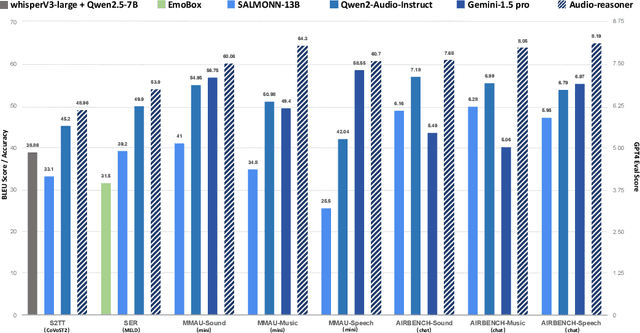
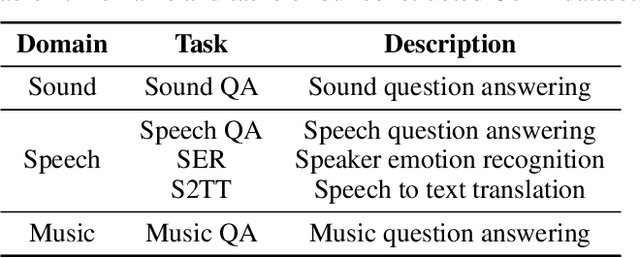
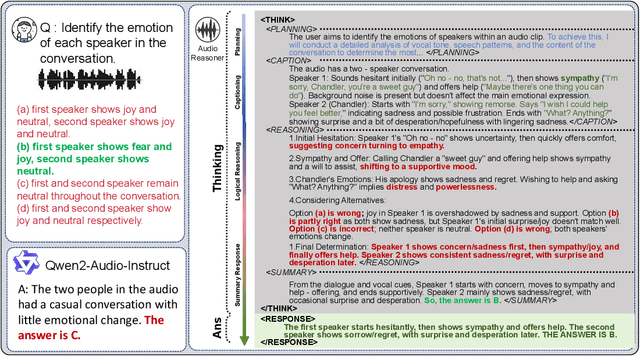

Abstract:Recent advancements in multimodal reasoning have largely overlooked the audio modality. We introduce Audio-Reasoner, a large-scale audio language model for deep reasoning in audio tasks. We meticulously curated a large-scale and diverse multi-task audio dataset with simple annotations. Then, we leverage closed-source models to conduct secondary labeling, QA generation, along with structured COT process. These datasets together form a high-quality reasoning dataset with 1.2 million reasoning-rich samples, which we name CoTA. Following inference scaling principles, we train Audio-Reasoner on CoTA, enabling it to achieve great logical capabilities in audio reasoning. Experiments show state-of-the-art performance across key benchmarks, including MMAU-mini (+25.42%), AIR-Bench chat/foundation(+14.57%/+10.13%), and MELD (+8.01%). Our findings stress the core of structured CoT training in advancing audio reasoning.
SoftCoT: Soft Chain-of-Thought for Efficient Reasoning with LLMs
Feb 17, 2025


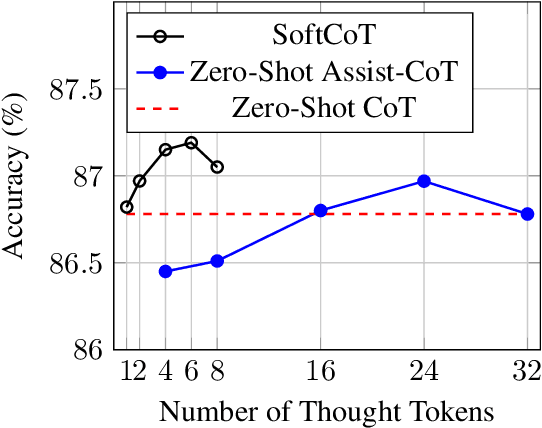
Abstract:Chain-of-Thought (CoT) reasoning enables Large Language Models (LLMs) to solve complex reasoning tasks by generating intermediate reasoning steps. However, most existing approaches focus on hard token decoding, which constrains reasoning within the discrete vocabulary space and may not always be optimal. While recent efforts explore continuous-space reasoning, they often suffer from catastrophic forgetting, limiting their applicability to state-of-the-art LLMs that already perform well in zero-shot settings with a proper instruction. To address this challenge, we propose a novel approach for continuous-space reasoning that does not require modifying the underlying LLM. Specifically, we employ a lightweight assistant model to generate instance-specific soft thought tokens speculatively as the initial chain of thoughts, which are then mapped into the LLM's representation space via a projection module. Experimental results on five reasoning benchmarks demonstrate that our method enhances LLM reasoning performance through supervised, parameter-efficient fine-tuning.
MedRAG: Enhancing Retrieval-augmented Generation with Knowledge Graph-Elicited Reasoning for Healthcare Copilot
Feb 06, 2025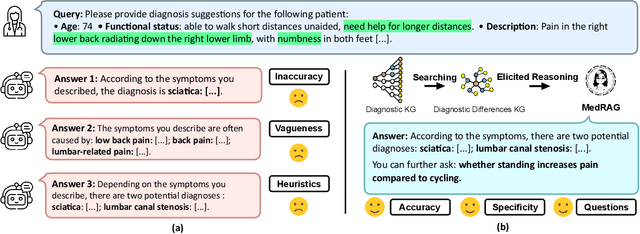

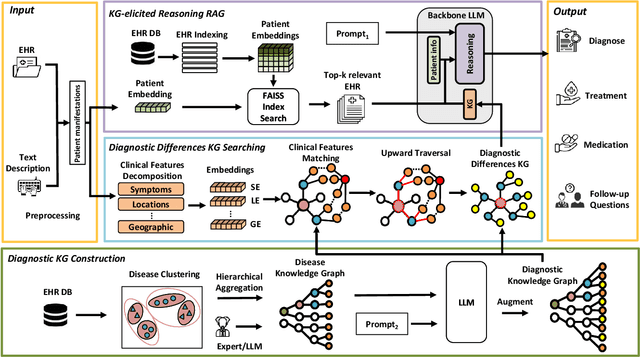

Abstract:Retrieval-augmented generation (RAG) is a well-suited technique for retrieving privacy-sensitive Electronic Health Records (EHR). It can serve as a key module of the healthcare copilot, helping reduce misdiagnosis for healthcare practitioners and patients. However, the diagnostic accuracy and specificity of existing heuristic-based RAG models used in the medical domain are inadequate, particularly for diseases with similar manifestations. This paper proposes MedRAG, a RAG model enhanced by knowledge graph (KG)-elicited reasoning for the medical domain that retrieves diagnosis and treatment recommendations based on manifestations. MedRAG systematically constructs a comprehensive four-tier hierarchical diagnostic KG encompassing critical diagnostic differences of various diseases. These differences are dynamically integrated with similar EHRs retrieved from an EHR database, and reasoned within a large language model. This process enables more accurate and specific decision support, while also proactively providing follow-up questions to enhance personalized medical decision-making. MedRAG is evaluated on both a public dataset DDXPlus and a private chronic pain diagnostic dataset (CPDD) collected from Tan Tock Seng Hospital, and its performance is compared against various existing RAG methods. Experimental results show that, leveraging the information integration and relational abilities of the KG, our MedRAG provides more specific diagnostic insights and outperforms state-of-the-art models in reducing misdiagnosis rates. Our code will be available at https://github.com/SNOWTEAM2023/MedRAG
 Add to Chrome
Add to Chrome Add to Firefox
Add to Firefox Add to Edge
Add to Edge